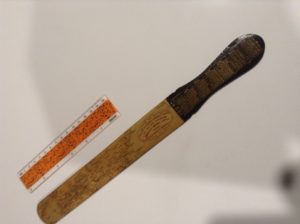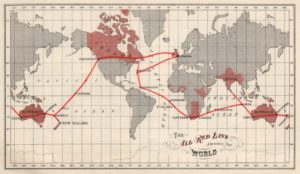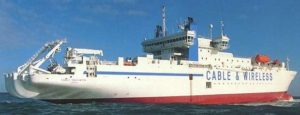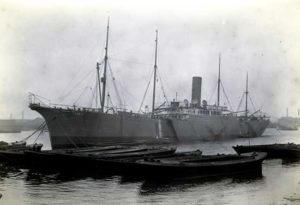By Fairlie Clifton
Fairlie Clifton is a long-term member of the Naval Historical Society and foundation member of the Australian National Maritime Museum where she volunteers as a guide. Her passion for naval history is fuelled in part by her strong nautical background. She has personal experience at sea in square riggers, yachts and cargo vessels. Similarly, the service of several family members in the Royal Navy and loss of another in HMAS Sydney II makes naval history very personal for her.
You may think the object in the photo below is a paperknife. It is not. There’s a tale here, perhaps several tales.

In 1890 my paternal grandfather, Frank Bellis Vincent Graves, joined Eastern Telegraph Company (ETC) as a cadet at the company’s head office in London. His whole working life was spent with the company, most of the time being posted to ETC’s cable stations in far distant places around the world, some of which I had never heard of (and my geography is good). He was born in India, taken by his mother to England as an eight year old to be educated – usual British Empire thing.
In the 1890s ETC was probably the most powerful corporation in the world. It was formed in 1872 when four much smaller submarine cable laying companies merged after they had each been laying sections of cable between the UK and the Far East. In 1872 Australia was linked to the system by a cable from Bombay via Singapore. Other nations had cable laying companies but ETC was by far the most dominant; after all, there was a large empire to service. As the networks expanded, only very fit, young, adventurous and mostly single men were employed as ‘cablemen’ and sent off to various, often remote cable stations around the world, there creating a little piece of England. By 1902 there was an ‘All Red Line’ of British cables around the world.

During the First World War cablemen were classed as essential war workers and were required to stay with the company and not sign up for active service. However, many of these young men were torn between their desire to join up and the need for their services to keep Empire communications going. A few did resign and then enlist. Unfortunately many of those who remained were frequently accused of cowardice and presented with white feathers, which must have been very hurtful. The company was protective of them and issued a special wartime service lapel badge for them to wear. Pay was also increased as some compensation.
A few cablemen left the company to work on cable ships, which in both World Wars were considered to be prizes of war and liable to be sunk on sight. One of the ETC’s cable laying ships, Levant II, was from the earliest hours of the Gallipoli landings busy laying and maintaining cables close to shore to provide communication for allied troops. She remained in the area throughout the Gallipoli campaign and had some narrow escapes. Her master was subsequently awarded the DSC and five members of the crew were mentioned in dispatches.

Even while continuing to work for ETC, cablemen experienced some dangerous situations at station postings in WWI. One of the most famous ETC stations, certainly to us in Australia, was the strategically important Cocos Keeling station on Direction Island, which in November 1914 was captured by a well-armed landing party from the German cruiser SMS Emden. The cable boys on shore were quick to send off an SOS when they realised an enemy ship was approaching. The message was picked up by a passing troop convoy, and the news reached ETC London HQ in minutes. One of the convoy escorts, HMAS Sydney I, was despatched at full speed to intercept Emden, which was destroyed in the ensuing battle close to shore.
Before Sydney’s arrival the station staff were herded into their mess under guard while the Germans destroyed equipment. They also cut through the Perth cable and tried unsuccessfully to hack through another, not realising that this one was a decoy which had been hastily rigged by station staff. When it came to dynamiting the radio mast, the cable boys politely asked if this could be done so as not to damage the tennis court. The Germans obligingly complied.
Having become stranded following the destruction of their ship, the Germans commandeered a schooner anchored in the lagoon and set sail. Their seven-month journey home by various means over sea and over land is in itself an extraordinary tale. Meanwhile, back at Cocos Keeling, repair of equipment commenced immediately and the station was back in action by the time the Germans reached Bombay.
In September 1914 there was a very similar raid on the mid-Pacific Fanning Island cable station. On that occasion the German raiding party had got away safely as there was no allied ship to attack their ship, the cruiser SMS Nürnberg, which had been detached from the Imperial German Navy’s East Asia Squadron for this raid. Fanning, almost on the equator (3°51′36″N159°21′52″W) is now part of Kiribati and is very remote indeed. Nürnberg rejoined her Squadron, which then defeated the RN’s West Indies Squadron at the Battle of Coronel off the coast of Chile. Her crew may have survived that battle but perhaps not the next one a month later, the Battle of the Falkland Islands, when almost all the German ships, including Nürnberg, were destroyed.
During the Second World War cable laying and cable repair ships were constantly in action all over the world, and a number were sunk by enemy action. The slow, careful work required to lay or lift cables, often in difficult sea conditions, can make them an easy target. In WWII the ships often moved through narrow swept channels between minefields and quickly moved in behind troop landings to lay new cable. Soon after the D-Day landings a cable ship was used to lay PLUTO (Pipeline Under the Ocean) from the Isle of Wight to the Cherbourg peninsula to supply petrol to the fighting forces.
Of course, destroying enemy submarine cables was always an important task. And if the supply of cable was particularly short – well, just do a snip here and a snip there and make off with a piece of cable to be put to your own use. Italy lost 450 miles of cable in this way, lifted from a depth of 2000 fathoms despite U-boat activity in the recovery area.
Back to the mystery object
For a number of years in the late 19th and early 20th century ETC head office sent out promotional gifts at the end of each year, and this 32cm long object was one of them. They are not paper knives but map turners, probably smaller versions of the ones used to turn the pages in the huge map books which were used at head office. On the black handle is the date (1894 on the mystery object) and the year’s calendar, six months on each side. On the blade is a map of the world, northern hemisphere on one side and southern on the other, with the company’s vast network of cables shown in red. They were manufactured in Mauchline (pron. ‘mock-lin), a small town in the Scottish Lowlands, using local sycamore wood which is light and can be cut very finely. This trade also had its origin in the early- to mid-19th century when railways were expanding, populations were becoming more mobile, and people wanted souvenirs of their holidays. For about 70 years British tourist souvenirs were made of Mauchline ware, which is now apparently very collectable.
Quite by chance when investigating ETC history on line, I found a picture of one of these map turners and asked Mr Google about it. I found that the National Library of Australia and the Queensland Museum each have one in their map collections. I also found three on UK eBay at prices ranging from £300 to £770 and all with minor scratches and signs of use. Finally, just for fun, I looked on local eBay and found one there, in Australia, with an asking price of A$150. I had to have it, of course. It occurred to me that the seller was not really aware that the object could have some value, and this impression was borne out when it arrived, packed in an unpadded PO bag, diagonally so that it only just fitted in, and wrapped in two sheets of kitchen paper towel and a strip of folded cardboard torn from a box and very roughly taped. It survived, and it’s in mint condition!
A bit of history
Laying all those submarine cables entailed fleets of specialised cable laying and cable repair ships owned by cable manufacturers, cable owners and communications companies, with Great Britain leading the way. In the early days inventing and manufacturing suitable cable was a great challenge.
The invention and laying of submarine telegraph cables was, of course, one of the extraordinary achievements of the Victorian age. In prosperous Victorian times there was a ready supply of entrepreneurs to invest in this costly and risky new technology which within a few short years provided instant communication between continents and, as a result, extraordinary change in world affairs. This instantaneity was not necessarily well received by Her Majesty’s overseas ambassadors, governors-general, admirals and generals, previously independent VIPs, some of whom regarded the new technology as a tiresome inconvenience and were seriously miffed by having head office just a few Morse taps away.
Submarine cable laying started in the early 1850s with short lengths of cable around Britain and across the Channel and in 1858 extended to the first, but not successful, transatlantic cable. The first successful permanent transatlantic cable was laid in 1865/66 with more advanced technology, followed by the first cable to India in 1870. By 1892 and until the 1920s Britain owned and operated two-thirds of the world’s submarine cables which serviced the Empire, and about the same proportion of cable ships. The first trans-Pacific cable became operational in 1902, linking North America, Australia and New Zealand. ETC continued to grow into the 20th century until in 1934 the company became known as Cable & Wireless plc, still a prominent company in British communications.
Manufacturing submarine cable was big business in the 19th century and is big business in the 21st century. The early challenge, of course, was how to develop a completely watertight cable which could withstand the deep-sea environment.
Late 1840s: Early telegraph cables consisted of copper wires protected by bindings of jute, tar, soapstone and steel wire, and insulated by gutta percha. Gutta percha, a remarkable plant-based substance from Malaya, was widely used for many domestic and industrial purposes in Britain in the mid to late 19th century but particularly for cable insulation. Synthetic materials replaced it in the 20th century but it is still used in dentistry.
1892: two-thirds of the world’s submarine cables owned by Great Britain
1896: 30 cable ships in the world, of which 24 were owned by British companies
1900: global telegraphic cable network established
1950s: switch to coaxial telephone cable communication – costly and limited capacity
1970s: fibre-optic technology developing
1986: first international fibre-optic cable laid across English Channel
1988: first trans-ocean fibre-optic cable laid / fibre-optic starting to outperform satellites
1990s: development of global communications highway in tandem with internet growth
2000s: well over 1 million kilometres of fibre-optic cable connecting the world – and growing see Submarine cable map 2019: https://submarine-cable-map-2019.telegeography.com/

The submarine cable network now carries 98% of the world’s cross-ocean digital traffic, including email, texts, financial transactions and top-secret military and government communications. The network’s carrying capacity is much greater than that of satellite communication and is more efficient.
Once laid, submarine cables are prone to damage by volcanic eruptions, earthquakes, sealife, currents, anchors and fishing vessel equipment, particularly the latter. In the 1990s burying cables in the ocean floor began. Cable breakdowns do occur, even with the most modern technology, although nowadays these faults can be detected quickly from on shore as well as on board. To see how this is done, have a look at this video on You Tube, 20,000 Cables under the Sea
Manufacture of the world’s cables is provided by only a handful of companies in a very competitive market. The largest manufacturing companies today are Prysmian SpA, followed by Nexans SA.
And what about the ships that lay and maintain the cables?
It is 170 years since the first successful submarine cable was laid in 1850/51 from Dover to Calais. After other shorter cables were laid, mostly around northern Europe, it was not long before a transatlantic cable was envisaged. For this, huge amounts of capital for such a risky and costly venture were needed and, of course, a suitable ship. There were some failures before the first successful permanent telegraph cable was laid across the Atlantic Ocean by Great Eastern, a mighty iron sailing steamship designed by Brunel.
Cable laying was Great Eastern’s second career after her five years as a passenger ship, which was not a commercial success. Being the largest ship in the world and exceptionally strongly constructed, she was the only ship able to carry the 2500 nautical miles of cable needed to lay the Atlantic cable successfully. She laid the cable from Ireland to near St John’s, Newfoundland where in July 1866 she was greeted by thousands of people and great celebrations, as well as special church services to give thanks for this great enterprise.
Most cable laying in the 1850s to 1870s was done using temporarily converted vessels. In 1872/73 two purpose -built cable layers were built in Britain, and one cable repair ship in Denmark. Over the next century private cable, telegraph, communications and oil companies built up their fleets, together with the British government and GPO, the French and Japanese governments, the US, and several European and Japanese companies also owning ships. The Royal Navy and US military operated a small number of ships, mostly in the first half of the 20th century. Up to year 2000 by far the greater proportion of cable ships (about 50%) and most of the largest (10,000-14,000 grt) were owned by British entities. In that year about 100 cable laying and repair ships were operating around the world, and many more were expected in order to meet the rapidly increasing demands of data traffic.
Development of cable ships was broadly as follows:
Late 19th century: compound single screw propulsion / mostly small ships averaging 1500 grt and 155-250’ length
1890s: triple expansion, twin screw propulsion
1900: ships growing larger, operating over greater distances / smaller vessels retained for inshore work
1950s: diesel-electric propulsion and some oil engines / bow thrusters
1900-1960s: ocean going ships typically about 2500-4500 grt / largest about 9,000 grt
1970-2000: largest vessels 9,000-15,000grt
21st century: multi-purpose ships /ROVs to assist repairs and retrievals / computer controlled positioning systems to hold ship steady at precise locations
Seen in profile, a typical 20th century ocean going cable ship had elegant lines – long, lean and with clipper like bows. The bridge and accommodation superstructure was placed midships, leaving space forward and aft for circular tanks for new cable storage. Generally, there were 2-3 such tanks (4 for the largest ships), 2-3 bow sheaves, and 1-2 stern sheaves. Repair work was done via the bow sheaves, and new cable was paid out through the stern sheaves. Most ships were cable layers and repairers, while some were solely repair ships.

The work carried out on board was slow, tough and painstaking, often in difficult sea conditions and for long periods. Accommodation and amenities provided on board were therefore of a higher standard than on other ships.
A big change has taken place in the design of cable ships in the 21st century. The newest ships are powerful, snub-nosed multi-purpose vessels with the superstructure placed up front, and designed to lay cable in much deeper water. With the ships being held in one precise position, repair and maintenance can be done via the stern sheaves, removing the need for bow sheaves. The newest technology makes grappling and retrieving cable much easier. Two such vessels now being fitted out are:
CLV Leonardo da Vinci: LOA 171m / speed up to 14kts / designed to operate safely in winds up to 130kph / and lay cable in depths >3000m. Owned by Italian power/telecommunications company Prysmian Group, which now owns four cable ships. For a close-up look at her being towed through the Bosphorus Strait on her way from Tulcea in Romania to Norway for final fitting out, have a look at this You Tube video: https://www.youtube.com/watch?v=iNgWCGBakR8&ab_channel=CavitEgeTul%C3%A7a
CLV Aurora: LOA 149m / 17,000 dwt / up to 14kts / owned by French energy/telecommunications company Nexans. Next generation multi-purpose cable installation ship. Built Ulstein, Norway. See Aurora on You Tube: https://www.youtube.com/watch?v=L_pROFi83Hc&ab_channel=NexansNorwayAS
Strategic significance
Submarine cables have long been intelligence targets. At the start of WWI Britain quickly cut the five cables linking Germany to the rest of Europe and to North America, which put Germany at a considerable disadvantage, it having only wireless communication. The cable war resumed in WWII, with German and Italian cables being cut by Britain very early on. In the Cold War the cable networks of both sides were under close surveillance, and it is known that the US Navy planted listening devices on Soviet underwater communication lines. More recently Russia has been probing the locations of the US’s cables, using deep sea submersibles capable of cutting cables at depths where repair would be difficult. Not surprisingly, Russia is laying a submarine cable across the Arctic ocean to increase its defence capability.
Should new conflicts begin in the world, severing or jamming cables to interrupt vital communications will be just as likely as it was in the two World Wars, and even before then. Both China and Russia are closely monitoring western networks, using submarines and sophisticated oceanographic ships to tap secret communications, and focusing particularly on cable choke points such as the Straits of Malacca, the South China Sea and the Luzon Strait, to name three in our region.
The Australian government considers its submarine cable links to be vital to the national economy, and their protection is an emerging strategic problem. But how to protect them? They are out of sight but can be detected, and routes are shown on publicly available maps that alert shipping to their presence. 100-150 years ago the security risk was lessened by trusted companies laying British cables in British controlled or friendly territory but that’s not so easy in today’s fragmented world.
It seems that the cable wars are continuing in the 21st century as they have since the late 19th century. Grandfather would no doubt be astonished if he knew!
References:
History of the Atlantic Cable & Undersea Communications From the first submarine cable of 1850 to the worldwide fibre optic network.
Bill Burns, publisher and webmaster – https://atlantic-cable.com/
Evolution of Cable & Wireless, Part 1 by Bill Glover available at https://atlantic-cable.com/CableCos/CandW/index.htm
Direction Island Cable Station and the Battle of Cocos https://atlantic-cable.com/Article/1914BattleOfCocos/index.htms
Cable Laying at Gallipoli 1915-1916
Diary of A L Spalding, available at https://atlantic-cable.com/CableStories/Spalding/index.htm
Not Another Hero: ETC’s creation of the Soldier Hero and Company Man
by Wendy Gagen available at, https://atlantic-cable.com/Article/TCS/indexwg.htm




